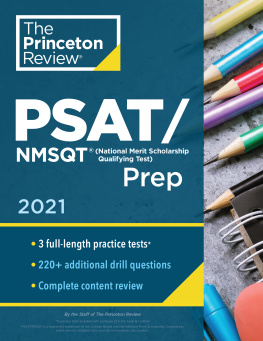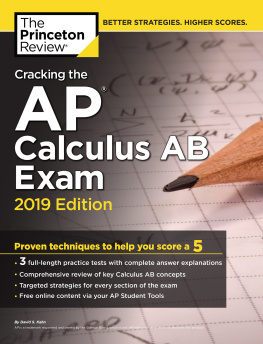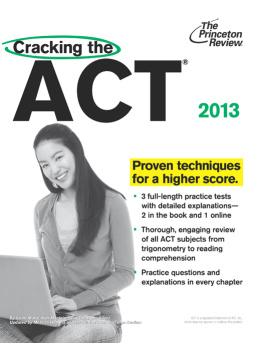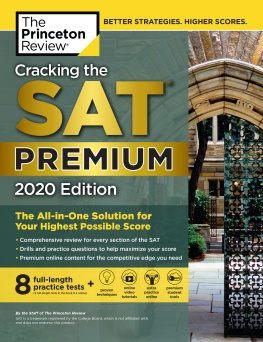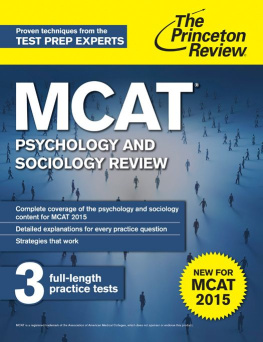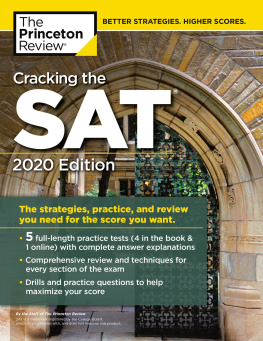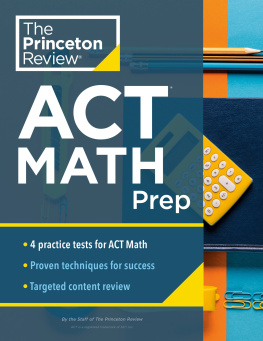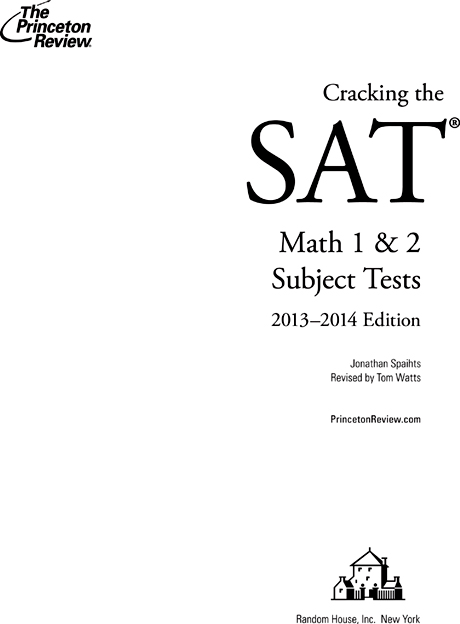Acknowledgments
Thanks to Tom Watts for his work on this years revision, as well as to reviewers Morgan Chase and Alexandra Schaffer, and the production team of The Princeton Review.
Special thanks to Adam Robinson, who conceived of and perfected the Joe Bloggs approach to standardized tests, and many other techniques in the book.
Contents
Chapter 1
Introduction
Welcome to the world of the Level 2 Subject Tests. This chapter will help you get familiar with this book and show you how to use it most effectively. We will also talk about when to take a Math Subject Test and which test is best for you. Lets get started!
TESTS?
The Math Subject Tests are standardized tests in mathematics. Colleges use these tests to assist in admissions decisions and to place incoming students in classes at the right level. The Subject Tests are written by ETS, a company in the business of writing tests like these. ETS makes money by charging students to take the SAT and SAT Subject Tests, and charging again to send the scores to colleges. Youll also run into ETS exams if you ever apply to graduate school.
Each Math Subject Test has 50 multiple-choice questions and is one hour long. The tests are scored from 200 to 800 points. Math topics, from basic algebra to trigonometry and statistics. There is substantial overlap between the subjects of the two tests, but they are nevertheless very different.
Many colleges require some SAT Subject Tests (frequently two, but occasionally one or three). The subjects available are varied: two in mathematics, three in science, two in history, one in English, and twelve in foreign languages. Different schools have different preferences and requirements for which tests to take, too. For example, an engineering program may want to see the Math Level 2 and a science. Check each schools website to determine how many tests you must take and which ones (if any) are preferred.
Whats on These Tests?
The content of each Mathematics test is approximately as follows:
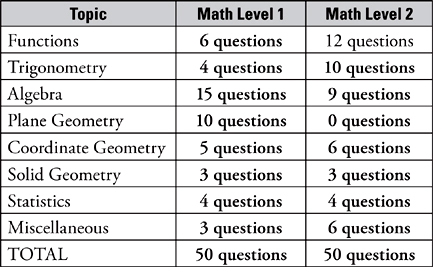
The Math Level 1 focuses on Algebra I, Geometry, and Algebra II, while the Math Level 2 focuses on Geometry, Algebra II, and Precalculus. The tests overlap, but the Math Level 2 tests more advanced material, and it tests basic material in greater depth.
For example, while both tests cover trigonometry, the Math Level 2 has more than twice as many questions on trigonometry, so it asks about many more different trigonometry topics than the Math Level 1 does. Similarly, the Math Level 2 rarely tests geometry except in the coordinate plane or in three dimensions, so that it can combine a geometry question (say, about triangles) with a xy-plane question (say, about slope).
Dont worry if you dont recognize some of the topic headings. Students taking the Math Subject Tests are not expected to have spent time on every one of these topics in school. Whats more, you can do quite well on these tests even if you havent studied everything on them.
Which Test Should I Take?
Taking the Math Level 1 is a fine idea for most students applying to more selective schools. You should base that decision on the admission requirements of the schools that interest you. The Math Level 2, on the other hand, is not for just anyoneits a much harder test. The great majority of students who take a Math Subject Test choose to take the Math Level 1.
Taking the Math Level 2 test is appropriate for high school students who have had a year of trigonometry or precalculus and have done well in the class. You should also be comfortable using a scientific or graphing calculator. If you hate math, do poorly on math tests, or have not yet studied Trigonometry or Precalculus, the Math Level 2 test is probably not for you. Its worth noting, however, that while the Math Level 2 test is difficult, the test is scored on a comparatively generous curve. If you find yourself making random (or silly) mistakes more than anything else, the Math Level 2s scoring grid may work in your favor.
Colleges also receive your percentile (comparing you to other test takers), as well as your scaled (200800) score. For the most part, they pay attention to the scaled score and ignore the percentile. However, to the small extent that percentiles matter, the Math Level 1 has considerably more forgiving percentiles. People who take the Math Level 2 are generally really good at math; about 13% of them get a perfect score! Less than 1% of Math Level 1 test-takers get a perfect score, though. As a result, a 790 on the Math Level 2 is only in the 85th percentile (about 13% get an 800 and 2% get a 790), while a 790 on the Math Level 1 is still 99th percentile. The disparity between the percentiles continues down the entire score range.
If you are very unsure about which test to take, even after working practice questions and taking practice tests, you can take both tests.
WHEN SHOULD I TAKE A MATH SUBJECT TEST?
The right time to take a Math Subject Test varies from person to person. Many students take the test at the end of a Precalculus class in school. (Precalculus also goes by many other names, such as Trigonometry or other less recognizable names.) Some students take Math Level 2 during or at the end of an AP Calculus course. A few students take Math Level 1 after taking Algebra II, especially if they will not take another math class in high school; such timing must be chosen with caution, because some students who have not taken Precalculus have not seen enough trigonometry to answer some questions on the Math Level 1.
The SAT Subject Tests are offered six times per year, and no test date is easier or harder than any other test date. The most popular test dates are in May and June, because these are at the end of a school year when the material is freshest in the students mind. Whenever you choose to take the test, make sure you have time to do some practice beforehand, so that you can do your best (and not have to take the thing again!).
The Calculator
The Math Level 1 and Math Level 2 Subject Tests are designed to be taken with the aid of a calculator. Students taking either test should have a scientific or graphing calculator and know how to use it. A scientific calculator is one that has keys for the following functions:
- the values of and e
- square roots
- raising to an exponent
- sine, cosine, and tangent
- logarithms
Calculators without these functions will not be as useful. Graphing calculators are allowed on both Math Subject Tests. The graphing features on a graphing calculator are helpful on a fairly small number of questions per test, and they are necessary for about 01 questions per test. If youre going to take a graphing calculator to the test, make sure you know how to use it. Fumbling over your calculator trying to figure something out during the test is just not a productive use of your time!
This book is going to focus on the TI-83. If you have another family member of the TI-80 series, know that these comments still apply to you with minor adjustments. Check with your manual for specific key stroke changes. If you have a scientific calculator, well be showing you your key stroke changes in the sidebars throughout the manual.


